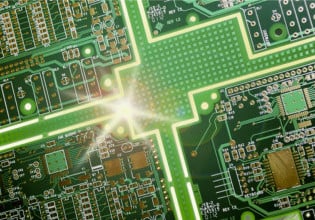Powering the Wearables Market: An Interview with Andrew Baker of Maxim Integrated
Maxim Integrated’s healthcare unit looks to make wearables more powerful and medically useful for consumers.
As the need for power products permeate the wearables market, Maxim Integrated looks to be an innovator in the booming space.
In this interview, we spoke with Andrew Baker, managing director of the Industrial and Healthcare unit at Maxim Integrated, about the MAX20340 Bi-directional DC Powerline Communication IC, a wireless earbud application that is composed of a PLC chip which minimizes the number mechanical contact points for the charging and communication interface. This product reduces cost, limits the possible points of failure and increases reliability.

Image 1: Image courtesy of Maxim Integrated.
Maxim has seen an increased demand for health sensing functions in wireless earbuds.
Globally, spending on healthcare is projected to exceed $10 trillion in the next two years. To be on the cutting edge of healthcare wearable innovation, Baker said consumers want power and practicality in their products.
EE Power: How have you seen health-based wearables in the power space evolve over the last decade?
Andrew Baker: As an industry, we went from simple step trackers and foot pods that just measured activity. It was mainly in the form of steps and to estimate things like calorie burn, which ended up not being very accurate. Then we had the application of heart rate measurement either using chest straps or wrist-worn devices.
These devices were measuring things and showing, “OK, I walked a thousand steps today. But what do I do with that information?” The user was really not being informed about what to do that was action-based on those measurements.
What we’re seeing now is more of what we call “actionable insights.” This data, along with multiple sensory modalities, is put together and then presented to the user in a way that would, for example, tell you if you should rest today because you overexerted yourself. It should really give you some kind of feedback and actions to take based on the measurement data. This is where we’re expecting the market to grow.

Image 2: Andrew Baker is the managing director of the Industrial and Healthcare unit at Maxim Integrated.
Image courtesy of Maxim Integrated.
EE Power: What trends are you seeing in the electronics wearables market that shows these kinds of Maxim Integrated devices will perform well?
Andrew Baker: We really look at the market in a couple of different ways. One is the consumer type products and we call those more preventative and predictive type devices — in other words, they're going to give you more of an insight into how you're doing along the way. The other aspect of wearable health is those devices that are managing or monitoring a chronic disease.
This is a category where these diseases need to be monitored very carefully and then ultimately you get better outcomes. The other side effect, the positive side effect, is the fact that hopefully the costs of managing these diseases actually go down.
One example of a major cost-saving is if you actually stop somebody from being hospitalized. If you can manage the disease in a way that you can predict and see an impending event that would cause the individual to be hospitalized, then you can save significant costs.
Big data is really the key to this. Getting more and more data, they're measuring more and more sensing modalities that basically put all those things together and figures out, "OK what do the users need to do? What are the recommendations based on the measured data?"
EE Power: What do you see consumers asking of electronic wearable devices?
Andrew Baker: We can look at what consumers want from our wearables in three different ways.
- What kind of measurements do we want to make?
- What are the benefits of those measurements?
- What are the features that people are looking for in their wearables?
Of course, the answer is different depending on everyone’s needs and requirements.
EE Power: What power devices does Maxim currently provide for wearables products?
Blood pressure monitoring — MAXREFDES220# Cuffless blood pressure reference design
- Meets Class-II regulatory accuracy limits
- Enables convenient optical blood-pressure monitoring without requiring bulky, expensive mechanical cuffs
Andrew Baker: Blood pressure is not necessarily something new to measure, but more and more people want to measure blood pressure in a more convenient form. There are various ongoing developments in that area to provide a cuffless solution, rather than using the uncomfortable cuff on your arm. There are also other methods that people are looking at to give you more convenient and continuous blood pressure measurements.
Heart Rate and Sp02 Measurements — MAXM86161 in-ear heart rate monitor
- Best-in-class SNR at lower power and highly accurate
- ~35% lower power to extend battery life
- 40% smaller optical solution size
- Fully integrated optical module for ease of design
- Uses Maxim algorithms for motion compensation to increase measurement accuracy
Andrew Baker: In terms of measurements, some of these measurements are either available today or in development, or desired. Heart rate is pretty much widespread. You get heart rate as a standard in almost every single wrist-worn heart rate device such as smartwatches.
Digital Temperature Sensing — MAX30208
- Clinical-grade temperature measurement accuracy (±0.1°C)
- Consumes only half the power
- Compact design
- Fast response time
Andrew Baker: We're seeing the deployment of temperature sensors also on wearables. Temperature is one of those things that, if you can measure it on the body, it gives a very good window into the overall health of an individual. This can also provide insight into impending issues, especially viral, which is a very hot topic these days.
What’s brand new about these applications is that consumers get the accuracy and they require half the power of existing solutions that you’ll find in the market.
Image 3: The MAX20340 can shrink power and communication footprint by up to 80% in true wireless earbuds.
Image courtesy of Maxim Integrated.
EE Power: What is the MAX20340 bi-directional DC powerline communication IC for wireless earbud applications?
Andrew Baker: The product that we enhanced is for wireless earbud applications. So the health angle to this is really that we’re seeing the desire to have health sensing functions in wireless earbuds. We see this as an increasing trend given the amount of attention this market segment is getting.
This product is to facilitate quite a simple but very critical function. Believe it or not, the wireless charging case that you get with these wireless earbuds is unable to communicate charge status without either having a native Bluetooth radio inside the charging case or adding additional connectors to the wireless earbuds so that the charging case can communicate the charge spaces back to your application on your smartphone.
The average wireless earbuds have two contacts to connect to the charger case. People don't want to have three or four LEDs on the charging case to understand charge status to a single-digit percentage accuracy level. They want to actually see the exact status on the app they’re using.
Each wireless earbud system requires three MAX20340 per system, one in each earbud and one in the charging case. It allows the earbuds to communicate with the charging case over the DC power line used to charge them.
It's a very simple, low-speed communication method but also gives the capability to optimize charging. So that you can imagine, the device itself is communication via directionally during the charge phase and then you can increase or decrease the charge rates depending on the overall system status. For example, if it is getting warm, you might want to reduce the charge current.
MAX20340 Bi-directional DC Powerline Communication IC
- Smallest solution size — shrinks power and communication footprint by up to 80% in true wireless earbuds.
- Reliability — Hosting communication and power over the same line reduces potential points of failure and cost.
- Ease of Design — Simple mailbox communication scheme for read and write functions are handled through an I2C interface.
EE Power: What was one of the biggest difficulties of making audio devices and healthcare-based wearables intersect?
Andrew Baker: One of the limitations with this is that obviously they’re very small. Real estate is a premium in terms of fighting for optimum position. The primary function of these devices is really audio. They tend to dominate the optimum position to get the best audio quality.
Bio-sensing, at least today, seems to be a secondary function. But, if you can make these sensors small enough and discrete enough, then they could be integrated more easily into these types of devices. That's what we're seeing is the semiconductor industry will get to integrating things. At Maxim Integrated, we make things smaller and more accessible, as well as lower cost for deployment. That is really the direction that things are moving in.
EE Power: What makes Maxim Integrated a company at the forefront of designing devices for wearables?
Andrew Baker: We look for growth opportunities where we can differentiate, and wearables are definitely an area that plays to Maxim's core strengths. Some of our core pillars are small size, low power, lower heat dissipation, and higher integration.
Wearables being a very space-constrained and power-sensitive area is an ideal scenario for us. It plays to our core strengths.

Image 4: Baker said spending on healthcare is set to grow by $10 trillion in the next two years and medical wearables are part of that projection.
Image courtesy of Maxim Integrated.
EE Power: What do you predict the market will look like for wearables in the next five years?
Andrew Baker: I think what's going to happen, and we're already seeing evidence of this, is that smartwatches will be a huge growth area. What we're seeing is that there are more and more measurement modalities being attached to the devices.
These devices are really about overall wellness — predictive as well as preventative. What we're seeing is that clinicians are actually suggesting or asking their patients to buy these types of devices so that they can monitor themselves.
With the advent of cloud analytics, machine learning, and AIs, we’re getting much more useful information out of these devices. Clinicians are starting to think that these things are useful. I think that’s going to drive adoption. As these devices get more and more technically sophisticated, it will also drive the refresh of these types of products.
In order to achieve the integration of these devices into everyday life, they need to be small, convenient, and unobtrusive. But the common theme on the design side is that because they need to be so small, there is not much room for batteries. So, in order to get there, every design needs to allow for peak power efficiency.
About the Interviewee
Andrew Baker received his BEng (Hons) Electrical Engineering at the University of Portsmouth. He worked as a managing director at Maxim Integrated, a company that develops innovative analog and mixed-signal products and technologies to make systems smaller and smarter, with enhanced security and increased energy efficiency. We are empowering design innovation for our automotive, industrial, healthcare, mobile consumer, and cloud data center customers to deliver industry-leading solutions that help change the world.







